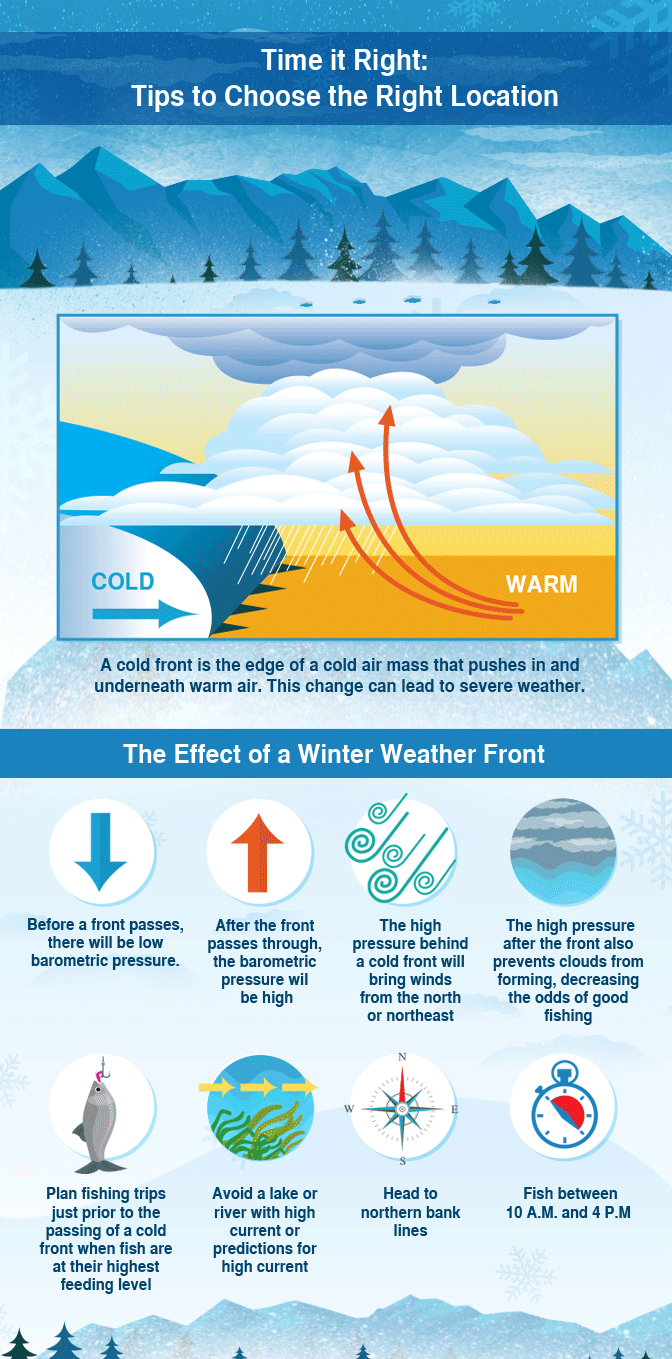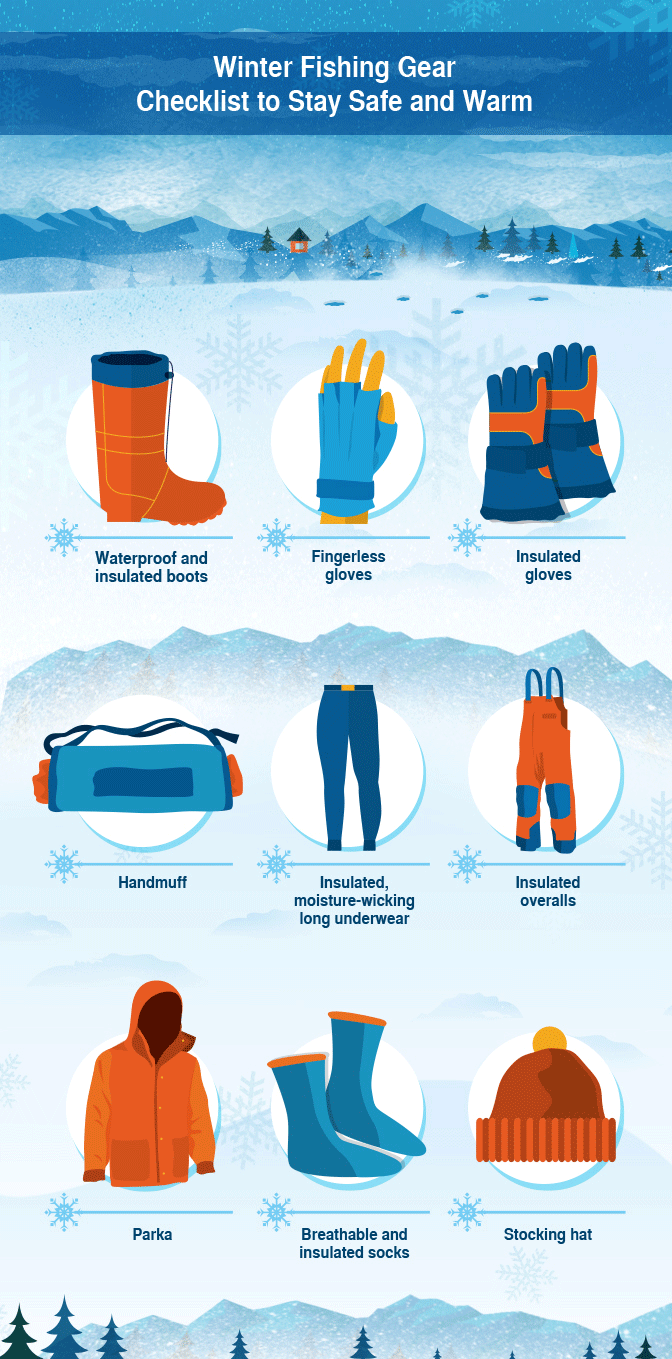Fishing through the winter months can be very rewarding for a number of reasons. Cold temperatures keep fair-weather anglers home and hunting seasons lead many anglers to trade lakes for the woods. Winter is also the time of year when most freshwater species group up. The result: more fish for cold-weather anglers. During the coolest months of the year, preparation, research, and the proper tackle can make for memorable fishing trips.
The first step in a successful fishing trip, no matter what species is being targeted, is to know where to go. The internet has a wealth of useful tools to guide anglers to fishing meccas. Department of Natural Resources or Wildlife and Fisheries websites are great resources for information about local lakes, and will detail what types of fish they have to offer, what times of the year provide the best angling for certain species, and any creel limits.
If the impoundment is run by the Corps of Engineers, a visit to their website provides lake levels and current flow predictions. Both conditions can affect safety and success. Very high lakes or ones experiencing overflow conditions will limit your chances, especially during cold-water months. Avoid a lake or river with high current or predictions for high current. Not only will the fishing be difficult, but elevated currents can also be dangerous and generate debris in the waterway. Look for lakes and rivers that are in normal winter condition and have a stable or natural current.
With a quick online search, it’s easy to find catching information as well. Most lake marinas have a website with up-to-date reports on which species are biting the best. Internet fishing forums are another good resource. Check out FishAssist.com for national information, or utilize regional websites. They can save you hours of fruitless effort.
While many of us have to plan fishing around work schedules, the weather is another consideration. A look at the forecast can narrow down which days will be more productive. Keep in mind that, while the best fishing conditions may not be the most comfortable for anglers, some conditions are sure to improve catching odds. Weather fronts affect the activity level of all freshwater species. In general, fish are more active prior to a front and less active after it. Whenever possible, optimize your chances by planning fishing trips just prior to the passing of a cold front. Since, however, most anglers are limited to fishing on the weekends, regardless of the weather conditions, here are some tips for fishing post-front conditions.
Low barometric pressure always precedes a front. After the front passes through, the barometric pressure will be high, bringing winds from the north or northeast and preventing clouds from forming in the sky. This will create picturesque days but not always the most fruitful fishing conditions. The bright sun, however, can be used to anglers’ advantage. During winter months the sun’s global position is further south in the sky. This allows it to shine very strongly on northern banks. A northern bank also prevents the cold, north wind from hitting the water. Wind protection and bright sun mean the water will warm faster during the day in these areas. For this reason, concentrate efforts on these northern bank lines.
During the winter, the best fish-catching times are typically between 10 am and 4 pm. That’s not to say a couple won’t bite at daybreak and dusk – they will just be few and far between. Take the opportunity to sleep in and enjoy a more comfortable fishing experience with the warming day.

Source: Fix.com
In general, winter fishing puts extra strain on fishing equipment. After determining where to go, make sure all your equipment is up to the task. To start, make sure the reels are in good working order. A reel bearing that was noisy or stiff under warmer conditions will completely fail in the cold. Old grease and oil will thicken, making reels difficult to use. To prevent frustration, clean and lubricate them. That way, when the perfect fish is hooked, you’ll be able to land it. If you’re not comfortable disassembling and cleaning reels, repair shops will perform this service for around $25 a reel – money well spent.
Cold winter conditions will make monofilament and fluorocarbon line difficult to manage. A line conditioner such as KVD Line and Lure, Reel Magic, Bass Pro, or Ardent will keep the line supple and prevent line twist, helping reduce backlashes and tangles. Use this same conditioner on rod guides to prevent water from freezing in them. Water from fishing line collects in the guides of a rod and, if it’s cold enough, will freeze and eventually stop the line from passing through the eyelet. Lastly, since it’s winter, there’s no need to worry about fish getting tangled in vegetation. Smaller diameter lines are just fine and will help prevent the effects of twist and stiffness.

Source: Fix.com
Choose the Best Bait
Lure choice in the winter months can be difficult; however, a few basic tips will greatly improve success. Live bait is the best choice, because it will react to the water naturally. Typically, anglers work artificial baits too quickly for the winter conditions. Both forage and predators are cold-blooded creatures and the cold water slows their metabolisms, making them move slowly. Bait that moves unnaturally quickly will turn fish away. Anglers trying to mimic these forage species should slow down their presentations to a methodically sluggish retrieve. Most anglers simply can’t fish slowly enough with artificial baits to accurately mimic the speed and movements of forage during winter temperatures. Live bait will be more enticing. Minnows or shiners are a great choice; so are live worms. However, they somewhat limit the species of freshwater fish that may bite.
Select artificial baits with hair and/or feathers. These provide more action in cold water than soft plastic baits, which get can stiff and lose the built-in action when water temperatures dip below 50 degrees. Hair and feathers don’t respond like this to cold water and, instead, maintain excellent action with little movement. Hair and feathers also move with water currents. Even when an angler imparts no action to the bait, it can still move very naturally, remain in the strike zone of the fish longer and mimic live prey.
If catching fish on lures is the goal, choose lures that will catch multiple species. Shad, herring, or yearling sunfish/perch will be the primary winter forage for all freshwater species, so match these forage species with lures. Most other forage species, crawfish, and other vertebrates will be hibernating and will emerge only after an extended warming trend. Soft plastic baits, including straight-tail worms, grubs, and tube baits, can be very effective. Choose colors that mimic the winter forage: anything white, silver, or transparent in color will work well, especially if they contain colored flakes. Hard baits such as crankbaits, spinners, and spoons can be very suitable on warmer days. Color choices for these baits should include chrome, silver, or gold.
In winter, it is important to use a reduced lure size. Cold temperatures drastically reduce a fish’s metabolism and the fish don’t need to feed as often. Smaller prey is easier to catch and digest. Presenting something small and slow best mimics the natural feeding habits at this time of year. Baits in the two- to four-inch range are perfect. If the goal is to catch the biggest fish in the area, use three- to four-inch baits, but if the goal is to catch the most fish possible, select baits in the two- to three-inch range.
Source: Fix.com
The most important tip for winter fishing is to be mindful of the weather and respect the conditions. Dress in layers, have a good game plan, and tell someone your timing and itinerary. If you should run into trouble, you’ll need help as soon as possible. Notifying a friend or family member of your location, expected travel route, and expected return time will help speed up the search process should something catastrophic occur.
With some planning and mindfulness of the conditions, you can have some of your most successful fishing adventures during winter months. Research your waterway, make sure your equipment is in good working order, and select multi-species lures or live bait, and you will be on your way to some of the best fishing our great country has to offer.

Source: Fix.com http://www.fix.com/blog/winter-fishing-tips/